
Posted on 02/12/2012 4:45:10 AM PST by Homer_J_Simpson

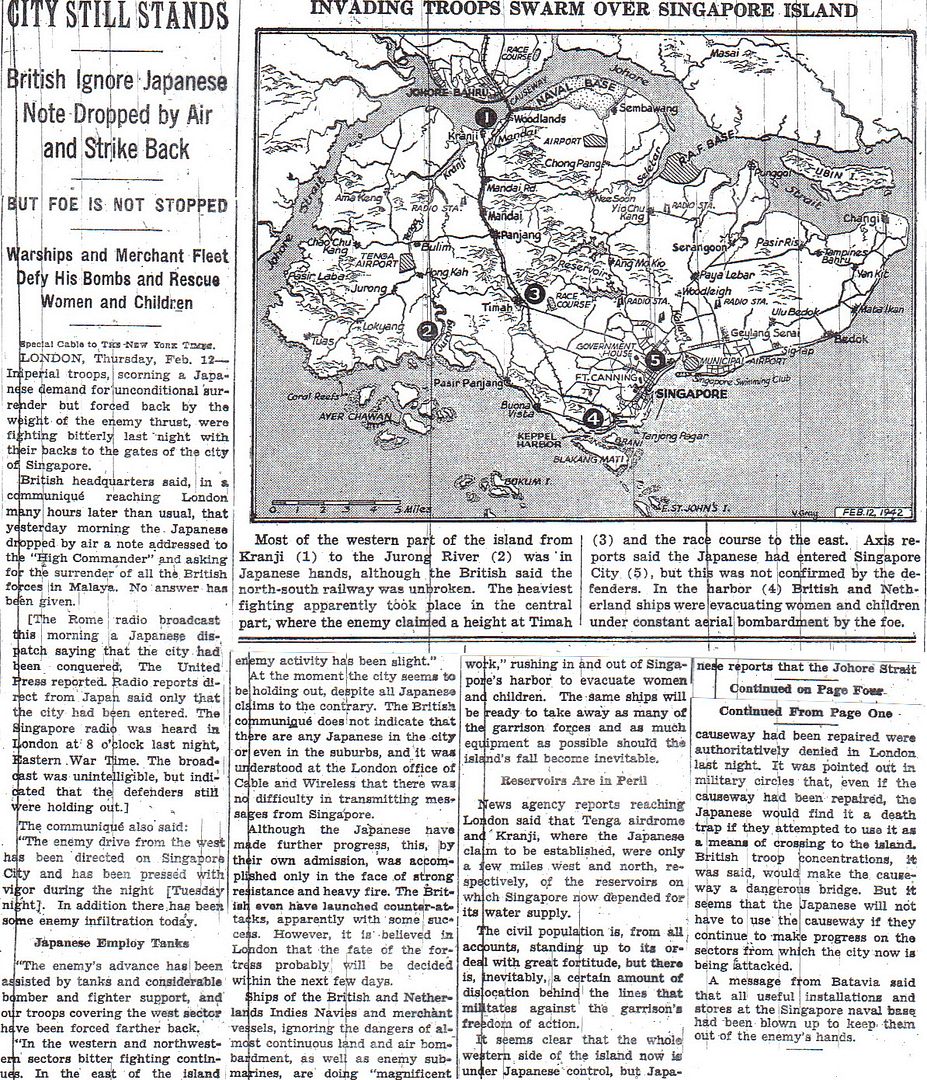
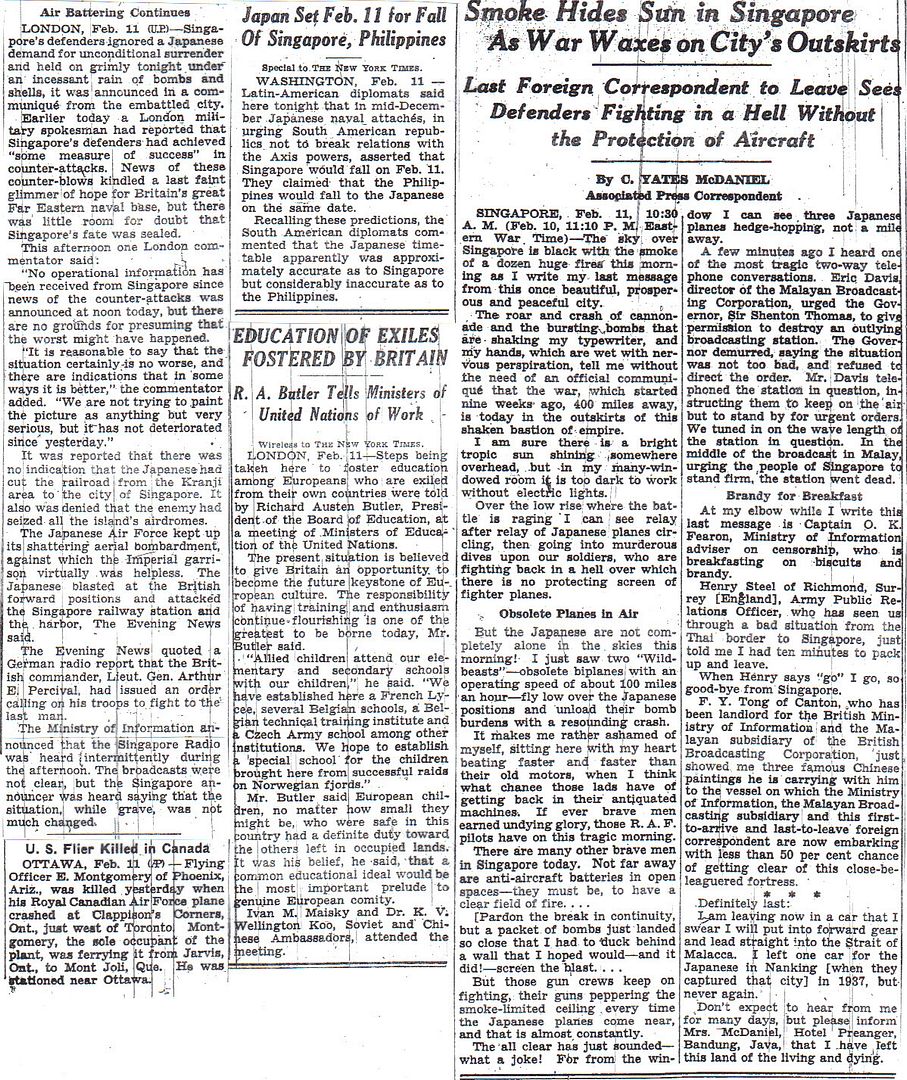
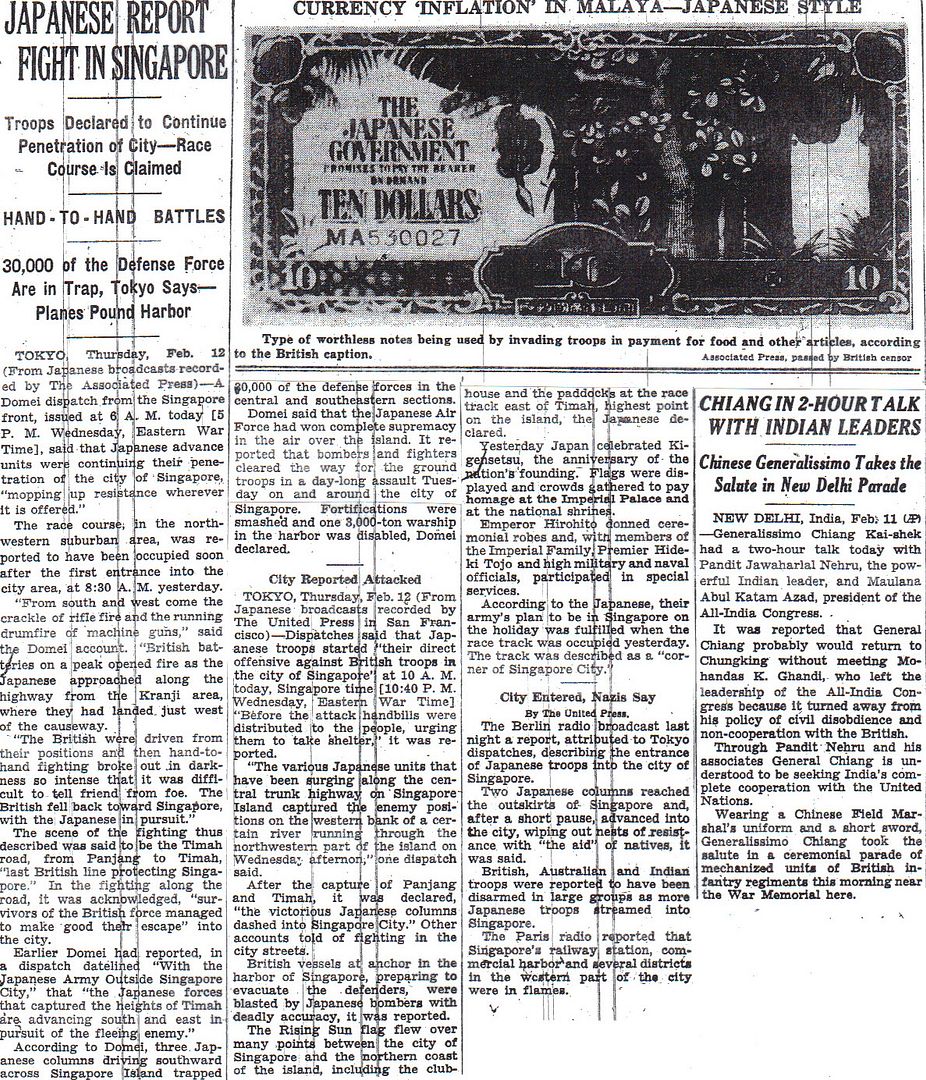
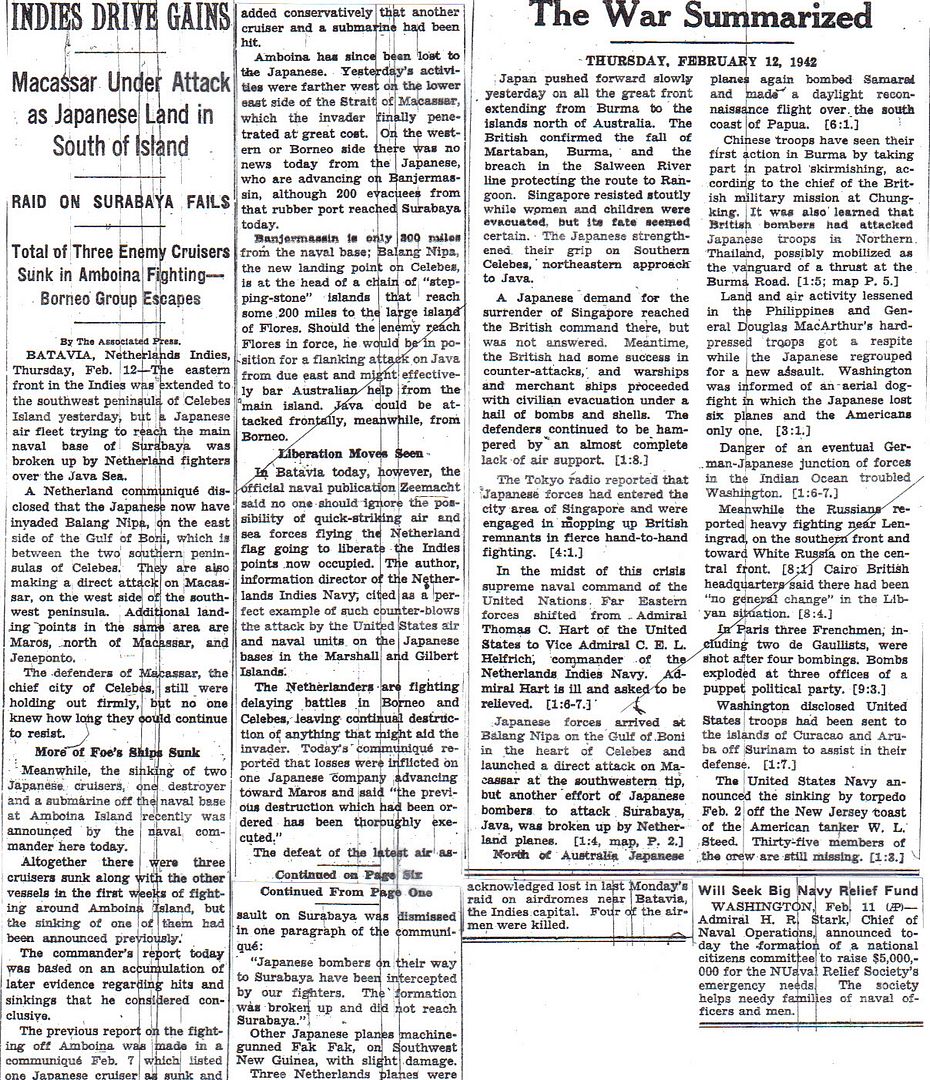
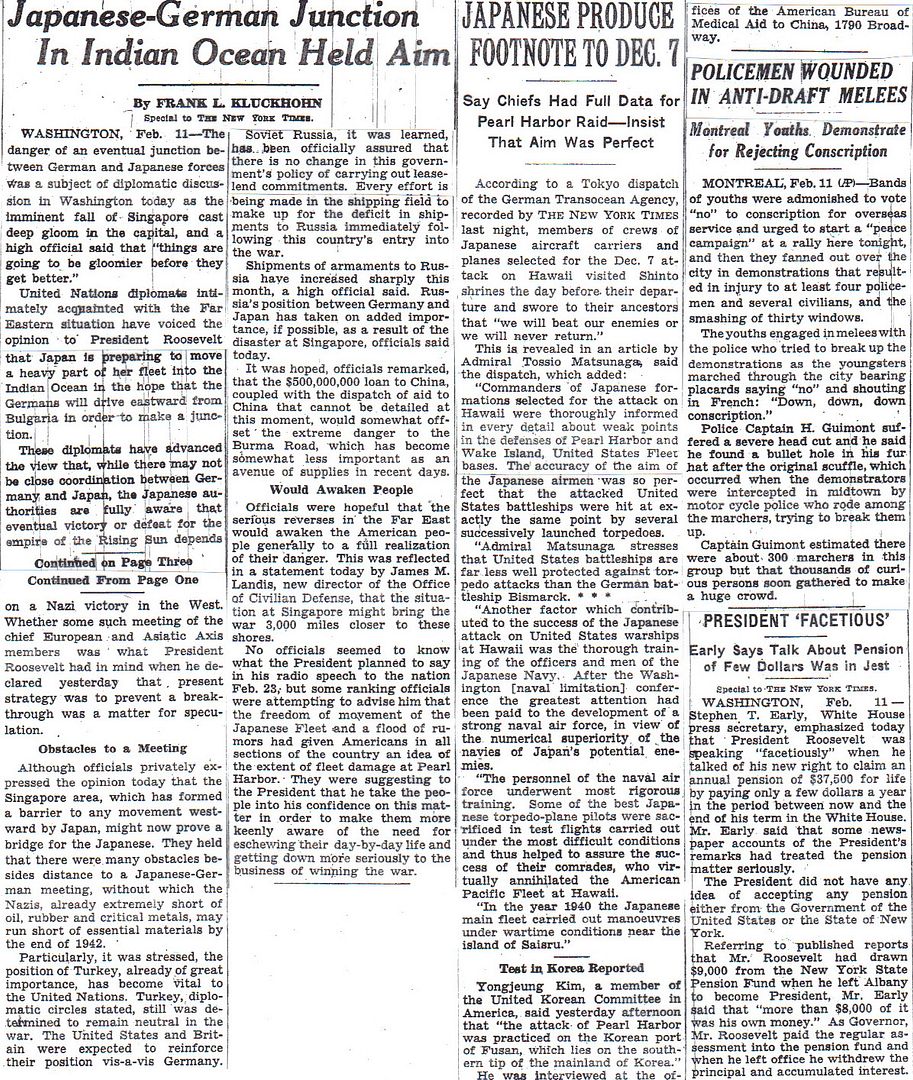
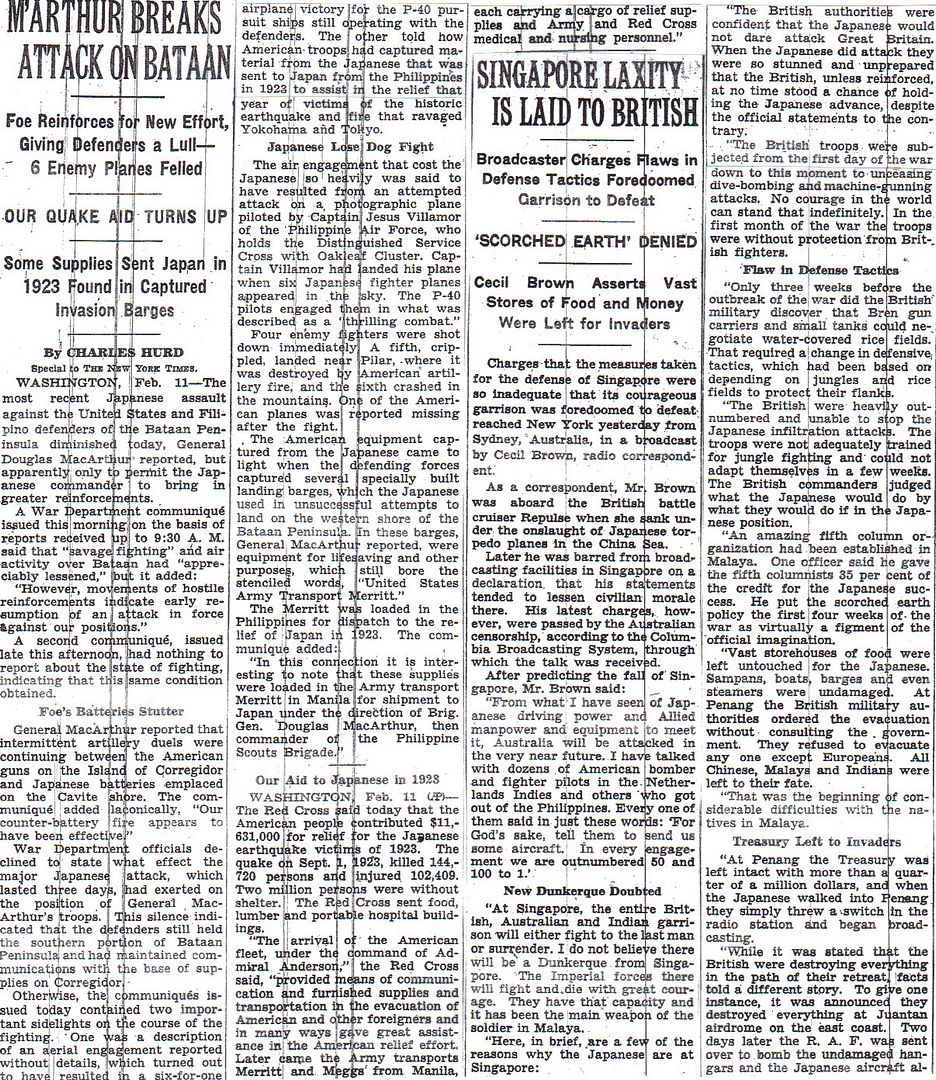


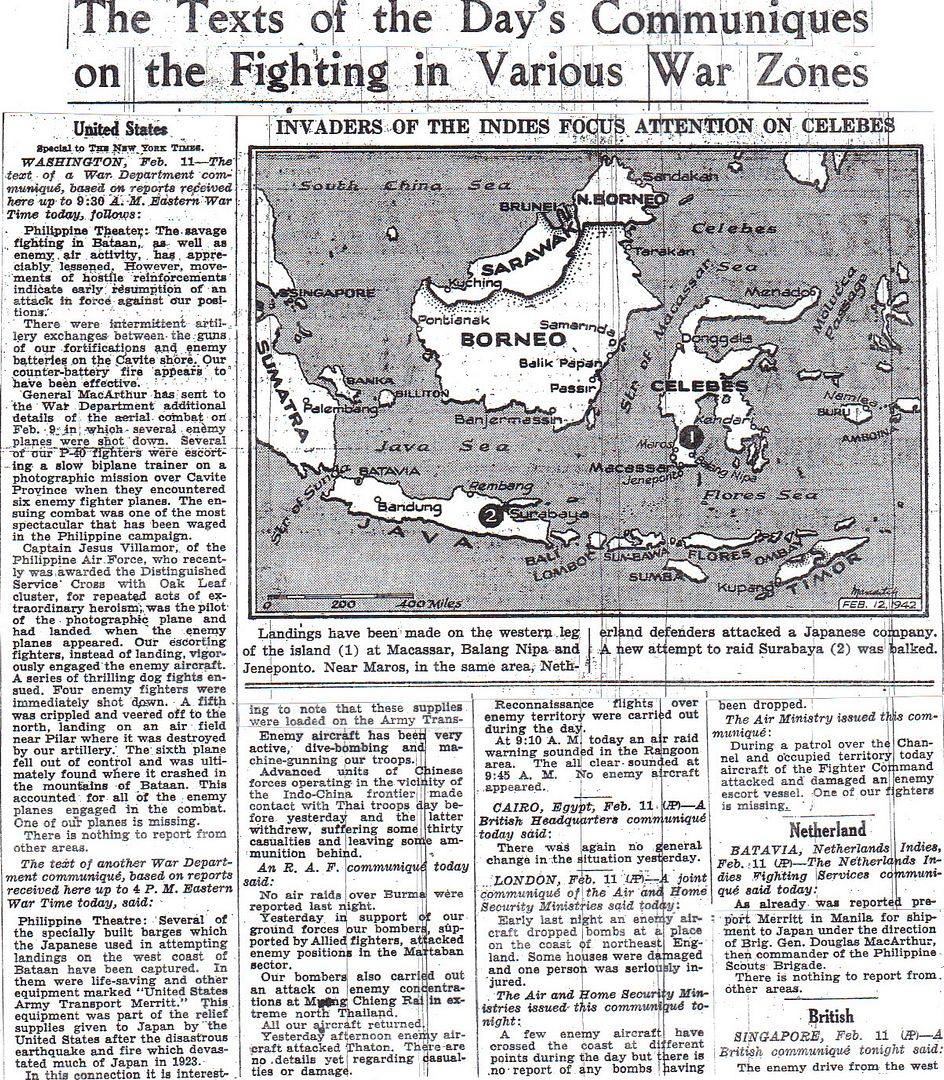
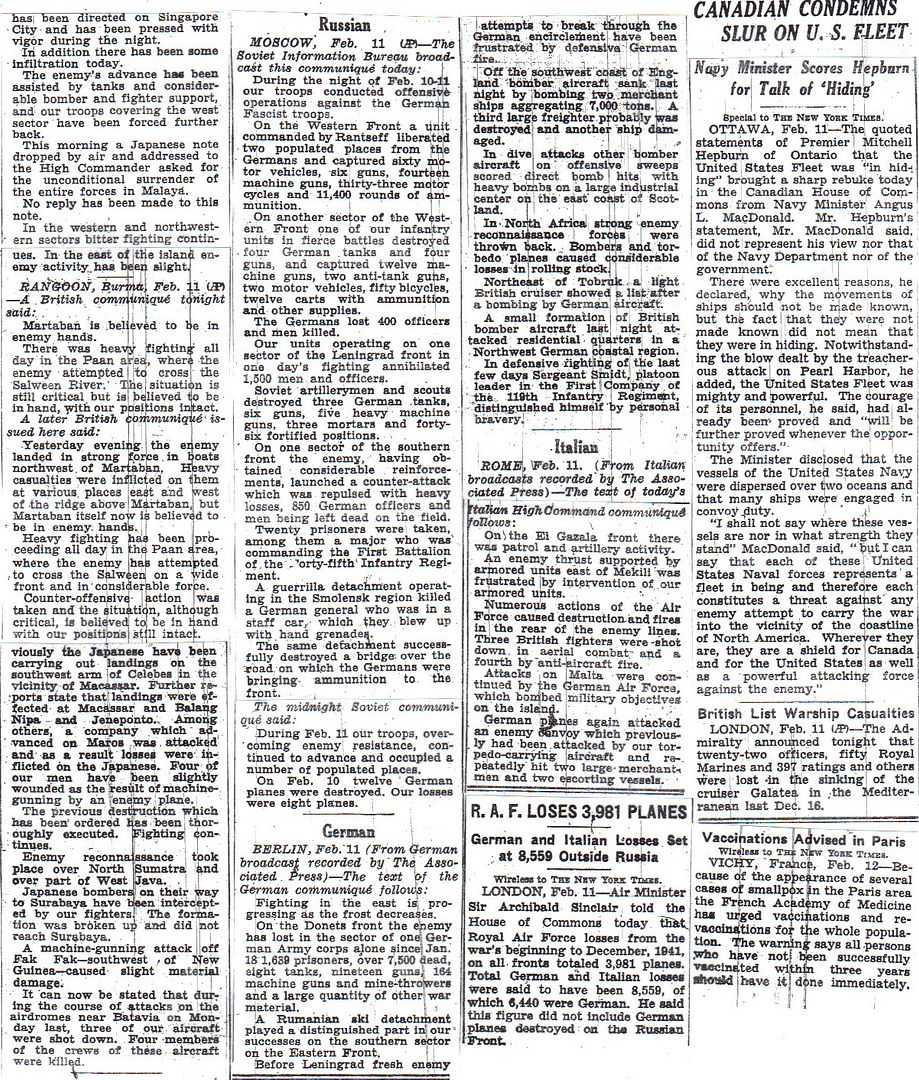
http://www.onwar.com/chrono/1942/feb42/f12feb42.htm
Allies form the Anzac Squadron
Thursday, February 12, 1942 www.onwar.com
In the South Pacific... The Anzac Squadron is formed at Suva in Fiji. It includes the cruiser Australia, USS Chicago, Achilles and Leander as well as two American destroyers.
In Seville... Spanish dictator Franco and Portuguese dictator Salazar meet.
In the Mediterranean... At Malta, the British destroyer Maori is bombed and sunk.
In the United States... Noted artist Grant Wood dies at age 49. He is known for his depiction of Mid-Western farm folk in paintings such as “American Gothic”.
http://homepage.ntlworld.com/andrew.etherington/month/thismonth/12.htm
February 12th, 1942
ENGLISH CHANNEL: To the fury of the British, three of Germany’s most powerful ships made a daring dash up the English Channel today. By this evening they were within range of the safety of the German ports.
The battle cruisers SCHARNHORST and GNEISENAU and the heavy cruiser Prinz Eugen had been sheltering at Brest since last spring. They had been prime targets for the RAF, and no fewer than 110 air raids had been made; damaging but failing to destroy them. The breakout had been ordered by Hitler and planned by Vice-Admiral Ciliax.
The German plan was called Operation Cerberus, but the British had heard about it through the French Resistance and had devised their own plan, Operation Fuller, to thwart it. The Resistance has observed the German preparations over the last few weeks, and last night 18 Wellingtons bombed the ships in Brest. They scored no hits, but they did delay the planned breakout for one hour, until 10.45pm.
This proved a lucky break for the Germans because the watching British submarine, HMS Sealion, decided that the fleet was not going to sail that night and pulled away. British forces were stood off. This morning at dawn, a pair of Spitfires from RAF Hawkinge patrolling the French coast noted unusual activity by light naval forces. The weather is bad, and getting worse, with snow on the ground, very heavy and low cloud, and poor visibility. At 0920, the Germans begin efforts to jam British radar along the South Coast. Given this unusual behaviour, a second pair of Spitfires are sent to investigate at 1020. On their return, they reported spotting a “convoy” including a possible capital ship. It was not until 11.09am today that an RAF Spitfire (one of two flown by senior RAF officers on a separate operation) spotted the German ships, by which time they were in the Straits of Dover. The Dover Castle guns fired, but fell short. The Eight boats from Ramsgate and Dover Motor Torpedo boats sped out, but could not get within range because of the powerful German E-boat escort. They did fire but at extreme range.
Six Swordfish of 825 Naval Air Squadron, which had earlier been moved from Lee-on-Solent to RAF Manston to help concentrate attacks in the chokepoint of the Dover Straits, led by Lieutenant-Commander Eugene Kingsmill Esmonde (b.1909), are ordered at 1130 to mount an attack as soon as possible. made a brave attack, despite the fact that their Spitfire escort was not ready. It was recognized that his slow and vulnerable aircraft would need significant fighter escort to survive. Three fighter squadrons from RAF Biggin Hill and two from RAF Hornchurch were ordered to accompany him. The Biggin Hill aircraft were to defend against the now very large Luftwaffe fighter escort covering the ships, whilst the Hornchurch aircraft were to accompany his torpedo bombers in a low level attack, distracting anti-aircraft fire and strafing the ships to keep gunners heads down. However, the Hornchurch fighter controller telephoned Esmonde to warn him that his squadrons simply could not reach the rendezvous by the allotted time. The timing was also exceptionally tight for the nearer Biggin Hill units. But Esmonde feared that even a short delay might take the German ships out of reach. As soon as the first ten Spitfires from 72 Squadron appeared overhead at Manston at 1228, he set off with his Swordfish, with only one-fifth of his planned escort. The RAF Station Commander at Manston said of Esmonde - “He knew what he was going into. But it was his duty. His face was tense and white. It was the face of a man already dead. It shocked me as nothing has ever done since.” German fighter attacks began only ten miles out from the English coast. The Spitfires engaged, but found it impossible to keep track of both their opponents and the Swordfish, flying at only about 100mph at very low level. The other two Biggin Hill squadrons arrived to engage German fighters in the general area. One Spitfire was lost, and two Messerschmitts were thought to have been destroyed. Esmonde’s six Swordfish pressed on alone, under heavy fighter attack and then, as the battlecruisers came into sight, intense anti-aircraft fire. The lower port wing of Esmonde’s biplane was shot away, but he somehow managed to keep flying until he was eventually shot down and killed with his two crewmen just before he got in torpedo range. The two Swordfish with him managed to drop their torpedoes before being shot down; five of their six crew survived. The second section of three Swordfish were also all shot down, with the loss of all nine men aboard. Their efforts were in vain, with no torpedoes hitting their targets. Esmonde was awarded a posthumous Victoria Cross, and the other seventeen men were also decorated. Seven Beaufort torpedo-bombers of 217 Squadron attempted to find their targets in the bad weather, and eventually five attacked, without success. Fighters shot down one. Other Beauforts and Hudsons attempted attacks, with the loss of four aircraft. Meanwhile, six elderly Royal Navy destroyers usually used for convoy duties, dashed south along the East Coast, coming under several air attacks. A squadron of RAF Whirlwind fighters was sent out to try to ward off the Luftwaffe, but was bounced and lost four aircraft. The effort proved too much for the worn engines of HMS Walpole, and she had to turn for home. The other five made radar contact at 1517, and ran in under heavy fire. The destroyers were repeatedly straddled, and HMS Worcester set on fire. Torpedoes were fired, but once again the range proved too great for accuracy. However, all the destroyers survived and retired to Harwich. Bomber Command RAF mustered 242 bombers to attack the ships off the Dutch coast before dark. Visibility was by now appalling, down to 1000-2000 yards in heavy rain, and the very low cloud base meant that bombs could not be dropped from sufficient altitude to have a chance of penetrating armour. 39 bombers were able to attack the German ships or their escorts, but 188 could not find them, and 15 were shot down. Fighter Command also sent up a total of 398 fighters - 102 strafed German patrol boats in the area, and claimed 16 enemy aircraft shot down, for the loss of 17 RAF fighters. But it was not until late tonight that mines - dropped by the RAF - succeeded where bombers had failed. The battle cruisers were damaged, SCHARNHORST seriously, as they neared German waters and ports. The RAF lost 42 aircraft.
The failure to sink them was regarded in Britain as a humiliating failure. The Times leader on 14 February complained - “Vice-Admiral Ciliax has succeeded where the Duke of Medina Sidonia failed... Nothing more mortifying to the pride of sea power has happened in Home Waters since the 17th Century.” But perhaps the fairest judgement came from a senior German officer, General-Admiral Saalwachter - “Our achievement should not disguise the fact that the dangers were still extremely high. We have without question been blessed by considerable good fortune, even when one considers the full significance of our initiative, use of surprise, good planning, strong fighter cover and strict security. I would also consider that the high risks of such an operation do not alter with hindsight.” (Dave Shirlaw)
The first action by RAF Douglas Boston III light-bombers takes place when No. 88 Squadron attacks shipping. (22)
GERMANY: RAF Bomber Command dispatches 12 Hampdens and nine Manchesters to lay further mines in the Frisian Islands, although weather conditions were still unfavourable. Only eight aircraft laid their mines but all returned without loss, but one Hampden crashes in England.
U-364 laid down.
U-519 launched.
U-609, U-661 commissioned. (Dave Shirlaw)
SPAIN: Spanish dictator Francisco Franco and Portuguese dictator Antonio Salazar meet in Seville and report that they share many views. (Jack McKillop)
MEDITERRANEAN SEA: Three Allied supply ships leave Alexandria, Egypt, for Malta, but all are lost to enemy before reaching destination. (Jack McKillop)
MALTA: Tribal class destroyer HMS Maori is bombed and sunk in an air raid on Grand Harbour, Valetta, Malta. As the off duty personnel are sent ashore at night, there is only one casualty when Maori blows up. Her wreck is raised on 5 July 1945, towed out to deep water and sunk. (Alex Gordon)(108)
NETHERLANDS EAST INDIES: Three USAAF 5th Air Force B-17 Flying Fortresses on an antishipping damage a transport and a merchant cargo vessel. (Jack McKillop)
Ten 5th Air Force A-24 Dauntlesses arrive at a new auxiliary airstrip at Modjokjerto, Java. (Jack McKillop)
Submarine USS Stingray ended her second war patrol at Surabaya. But due to the dangerous situation there (Japanese air raids) she left for Fremantle, Australia shortly afterwards, arriving there on 3 March. (Dave Shirlaw)
FIJI: The Anzac Squadron is formed at Suva on Viti Levu Island. This naval force is composed of heavy cruisers HMAS Australia and USS Chicago (CA-29), the light cruisers HMNZS Achilles and HMNZS Leander, and the destroyers USS Lamson (DD-367) and USS Perkins (DD-377). (Jack McKillop)
COMMONWEALTH OF THE PHILIPPINES: On Bataan, the I Corps regains an important trail junction unopposed. In the South Sector, the Japanese try desperately to escape from Silaiim Point; they break through the Philippine line, but are overtaken as they push north toward the Silaiim River and are forced steadily toward the sea. (Jack McKillop)
SINGAPORE: The Japanese attack strongly at several points and make further gains. During the night of the12-13th, beach defence forces on the eastern and southeastern coasts are withdrawn to strengthen the defence perimeter around the town of Singapore. The Allied supply situation is deteriorating rapidly. Singapore is in chaos, covered with smoke, full of 500,000 refugees, with military deserters wrecking liquor shops, stealing cars from showrooms, and attacking food shops. Many civilians and deserters board ships of all sorts pulling out of Singapore in a desperate evacuation, which in turn are attacked by Japanese aircraft. (Jack McKillop)
TERRITORY OF HAWAII: The battleship USS Nevada (BB-36) is refloated in Pearl Harbor. Even though struck by a torpedo and possible up to three bombs, she got underway on 7 December 1941, the only battleship that did. While attempting to leave the harbor, she was hit again and fearing she might sink in the channel and block it, she was beached at Hospital Point. Nevada receives temporary repairs at Pearl Harbor and then sails for Puget Sound, Washington, for complete repairs. (Jack McKillop)
NEWFOUNDLAND: HMCS Snowberry departed St. John’s escort for convoy SC.69 to Londonderry. (Dave Shirlaw)
U.S.A.: Second production order for 410 Northrop P-61s is placed. (Jack McKillop)
The Air Force Combat Command activates the 10th Air Force at Patterson Field, Dayton, Ohio. This unit is intended to serve in India and control all USAAF units in China, Burma and India. (Jack McKillop)
Lieutenant General Henry H “Hap” Arnold, Commanding General USAAF, indicates that 16 heavy bomber groups, three pursuit groups, and eight photographic reconnaissance squadrons will be sent to the UK during 1942. Brigadier General Asa N Duncan, Commanding General 8th Air Force, requests that his force, inadequate for its intended mission under Operation GYMNAST (early Allied plan for the seizure of Casablanca and the invasion of northwestern Africa), be strengthened by several bombardment and pursuit groups. This move, if carried out, would require diversion of units originally intended for other task forces.
Washington: Columnist Walter Lippmann publishes a nationally syndicated column in which he says, “The Pacific Coast is in imminent danger of a combined attack from within and from without”. The Japanese navy has been reconnoitering the coast more or less continuously. The Pacific Coast is officially a combat zone; some part of it may at any moment be a battlefield. Nobody’s constitutional rights include the right to reside and do business on a battlefield. And nobody ought to be on a battlefield who has no good reason for being there.” (Scott Peterson) More...
Destroyer escort USS Andres laid down.
Destroyers USS Bush and Waller laid down.
USS PC-581 laid down.
Submarine USS Grouper commissioned.
Destroyers USS Butler, Coghlan and Gherardi launched.
Light cruiser USS Montpelier launched.
USS PC-571 launched.
USS SC-641 launched.
Minesweeper USS Sheldrake launched.
(Dave Shirlaw)
ATLANTIC OCEAN: At 0248, the Blink was hit by three torpedoes from U-108. The first went straight through the hull without detonating, but the next two hit amidships in the engine room, destroyed the radio station, killed five men and sank the ship east of Cape Hatteras. Two men were seen to lower a raft, but were never seen again. The other 23 survivors launched the starboard lifeboat, which capsized at 1045 in bad weather and one man drowned. On the next day 11 men were left, sitting in the boat with cold water up to their chests after the boat had capsized several times, one by one the others had died, including the master. On 14 Feb the boat with only six survivors left was spotted by the American-flagged Monroe in position 33.34N/71.41W. They were picked up and brought to a hospital in Baltimore. (Dave Shirlaw)
http://en.wikipedia.org/wiki/Douglas_A-20_Havoc
DB-7B / Boston III The DB-7B was the first batch of the series to actually be ordered by Britain, in February 1940. Powered by the same engines as the DB-7A, with better armor and, crucially, larger fuel tanks, these were at last suitable for British use in the light bomber role. This was the batch for which the name “Boston” was first reserved, but since the commandeered DB-7s entered service first, this batch became known as the Boston Mk III. Amongst other operations, they took part in the attacks on the Scharnhorst, Gneisenau and Prinz Eugen during their dash through the English Channel (Operation Cerberus) and the infamous raid on Dieppe (Operation Jubilee). Three hundred were delivered and some were converted for use in intruder and night fighter roles.
Hopefully something on the “Channel Dash” tomorrow.
The Channel Dash actually benefited the British in the long haul. First it removed the requirement that the Royal Navy either split assets or opsition their units to cover both a breakout from home waters/ Norway by the Kriegsmarine, as well as from Brest. Second, it removed a fairly powerful flotilla from a forward window on the Atlantic from sailing against convoys [at least convoys without battleship protection]; a flotilla that could outrun any heavy unit in the Royal Navy. Third, it allowed the Brits to concentrate Home Fleet in and around Scapa Flow, where it could cover breakouts from Norway and the North Sea much more easily.
Fourth, when it was over, the Germans still lost one capital unit [GNIESENAU], which was de-commissioned on Hitler’s order.
Having said that, CEREBUS was a brilliantly planned and executed operation. If I recall, Churchill almiost lost a vote of ‘No confidence’ over it.
Dear Homer,
I am fed up with the cannibalistic attitude that rules FR these days. I don’t know what drove JimRob to such madness... but, it’s probably going to end my participation, such as it was, at FR very soon.
Before they ZOT me... I did want to THANK YOU, very much.. for the extraordinary effort you have shown in the past two years with this series. Although I haven’t posted that often, I have been reading it nearly every day.. and, have enjoyed it immensely.
I will continue reading it.. until FR is no longer available to anyone on the web. (I predict, not THAT long).... but, will likely not be able to post anymore.
Thank you... thank you... thank you... for your never failing, dedication to teaching history.
Tim
Disclaimer: Opinions posted on Free Republic are those of the individual posters and do not necessarily represent the opinion of Free Republic or its management. All materials posted herein are protected by copyright law and the exemption for fair use of copyrighted works.